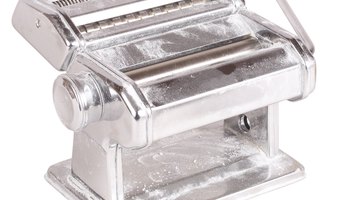How to Remove Rust From a Chrome-Plated Steel Pasta Cutter
Many cooks make their own pasta using a hand-crank or electric pasta cutter. Some pasta cutter manufacturers add chrome plating over the steel to form a rust and corrosion-resistant roller and cutter.

Through use and over time, however, the chrome plating breaks down, allowing moisture to remain trapped against the steel, which leads to rust. Removing rust from a pasta cutter is necessary to keep rust out of the pasta. Several cleaning options are successful for removing rust from a chrome-plated steel pasta cutter; choose the method you feel comfortable using.
Things You Will Need
- Salt
- Lemon
- Dish soap
- Cloth
- Container
- Cola
- Paper towels
- Toothbrush
- White vinegar
- Bronze or brass wool
- Aluminum foil
- Baking soda
- Scrub brush
- Powdered laundry detergent
- Potato
-
Sprinkle a generous amount of table salt on a plate. Cut a lemon in half and dip the fruit side of the lemon half in the salt. Rub the salted lemon over the rusty areas of the pasta cutter. Continue to dip the lemon in the salt and rub the pasta cutter surface until the rust is no longer visible. Wash the pasta cutter with dish soap, rinse it thoroughly with water and dry with a clean cloth.
-
Place the pasta cutter in a container. Pour enough cola into the container to submerge the rusted areas. If the rust is all over the pasta cutter and the pasta cutter is large, soak paper towels in cola and lay them over the pasta cutter. Continue to add cola to the paper towels to keep them saturated. Let the cola remain on the surface for 20 to 30 minutes. Take the pasta cutter out of the cola or remove the paper towels from the surface. Wet a toothbrush with cola a scrub the pasta cutter. If the rust comes away from the pasta cutter easily, continue to scrub. If the rust remains stubborn, soak the pasta cutter for an additional 20 to 30 minutes and scrub it again. Wash the pasta cutter with warm soap water and dry it thoroughly before storing.
-
Submerge the pasta cutter in white vinegar or lay white vinegar-soaked paper towels over the pasta cutter. Let the white vinegar sit on the pasta cutter surface for 30 to 45 minutes. Dip a piece of bronze or brass wool into white vinegar. Scrub the rusty areas of the pasta cutter until you no longer see rust. Wash the pasta cutter with dish soap, rinse with water and dry it completely.
-
Wad up a piece of aluminum foil with the shiny side facing out. Rub the rusty areas of the pasta cutter with the aluminum foil until the rust disappears. Wash and dry the pasta cutter.
-
Wet the pasta cutter with plain water. Sprinkle baking soda over the rusty areas of the pasta cutter. Let the baking soda remain on the surface for 30 minutes. Wet a scrub brush with water and scrub the rusted areas of the pasta cutter until no rust remains on the surface. Wash the pasta cutter and dry it with a clean cloth.
-
Mist the rusted areas with water. Sprinkle a generous layer of powered laundry detergent over the rust. Cut a potato in half and scrub the rusted areas with the cut face of the potato until the rust disappears. Wash the pasta cutter with dish soap, rinse and dry it thoroughly.
Tip
Prevent rust on chrome-plated steel pasta cutters by thoroughly drying all surfaces after washing.
Warning
Do not submerge electric pasta cutters; only soak the removable parts.
Do not allow rust to contact food.
The Drip Cap
- Many cooks make their own pasta using a hand-crank or electric pasta cutter.
- Some pasta cutter manufacturers add chrome plating over the steel to form a rust and corrosion-resistant roller and cutter.
- Continue to add cola to the paper towels to keep them saturated.
- Let the cola remain on the surface for 20 to 30 minutes.
- Wash the pasta cutter with dish soap, rinse with water and dry it completely.
- Rub the rusty areas of the pasta cutter with the aluminum foil until the rust disappears.
- Sprinkle baking soda over the rusty areas of the pasta cutter.
- Wet a scrub brush with water and scrub the rusted areas of the pasta cutter until no rust remains on the surface.
References
- "2,001 Amazing Cleaning Secrets"; Jeff Bredenberg; 2004
- "New Fix-It-Yourself Manual: How to Repair, Clean, and Maintain Anything and Everything In and Around Your Home"; Reader's Digest Editors; 1996
- "Baking Soda Over 500 Fabulous, Fun and Frugal Uses You've Probably Never Thought of"; Vicki Lansky; 1995
Writer Bio
Sal Marco began writing professionally in 2009. He has written many online home improvement articles based on his more than 20 years of experience in the home improvement and building industries. He has worked as both part of a team and as a site supervisor. Marco has a Bachelor of Science in management science from Kean University.
Photo Credits
- Hemera Technologies/PhotoObjects.net/Getty Images
- Hemera Technologies/PhotoObjects.net/Getty Images
More Articles



